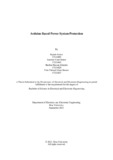Arduino based power system protection
Abstract
As the distribution of electricity networks has become more sophisticated, power system automation has become a requirement for every utility company like distribution substation, underground substation, switchyard, customer substation, and system station. The power system's efficiency highly depends on its inbuilt power types of equipment. It is vital to understand what kind of faults has occurred to improve the quality of the power station. Furthermore, suppose a power system's safety, monitoring, and control are insufficient. In that case, a critical monitoring system must be created to detect, monitor, and classify existing electrical power system problems.
The purpose of this project is to design and construct a system capable of collecting remote electrical characteristics such as voltage, current, and frequency and relaying them in real time to the power station. The concept of the online monitoring system incorporates a Global System for Mobile Communication (GSM), an Arduino MEGA single-chip microcontroller, and other sensors. The system's analog to digital converter (ADC) records the above characteristics at the distribution power system site. This project also uses a relay to protect the electrical wiring. This relay is engaged when the electrical parameters surpass predefined limitations. This system is capable of updating electrical parameters in real-time regularly. This system can be programmed to send alarms when the relay trips or when the voltage, current, or frequency exceeds predefined thresholds.
When our prototype is powered on, all of the sensors begin monitoring voltage, current, frequency, and temperature, transmitting real-time data to the server and displaying it on display. It compares all current values to specified values, generates a fault alarm, and refreshes the display if any values exceed or fall below the predefined values. If the problem continues for the predetermined time, the relay isolates the leads from the rest of the system. As is customary, the loads are reconnected to the rest of the system via relays while the comparison is being completed.

